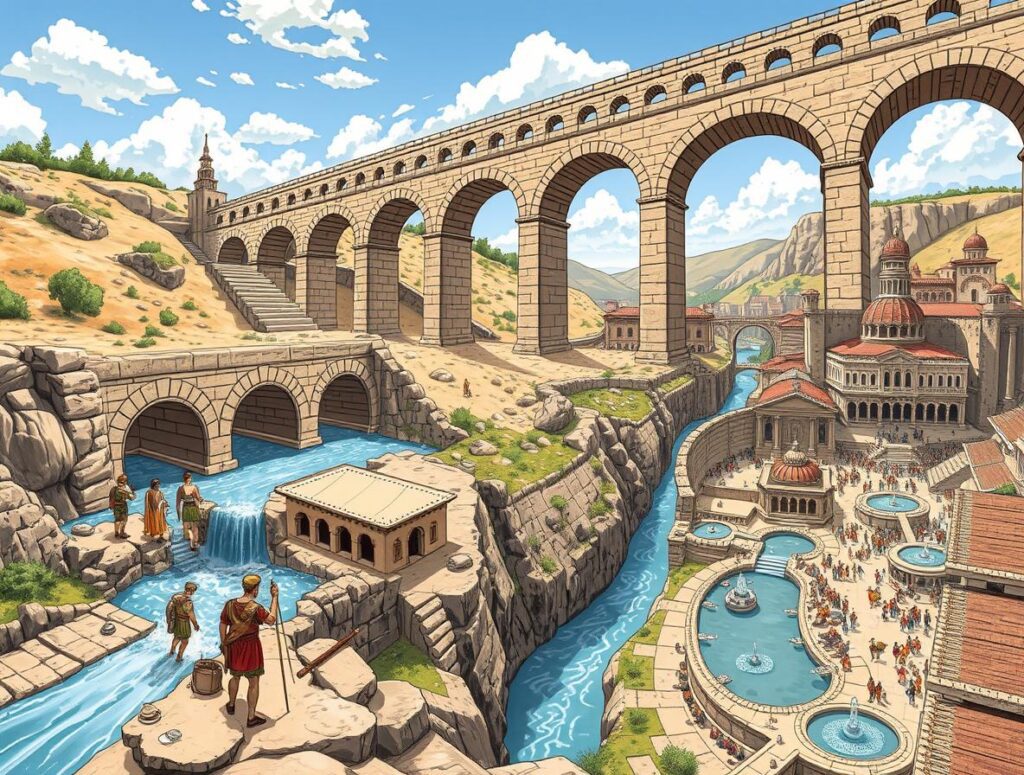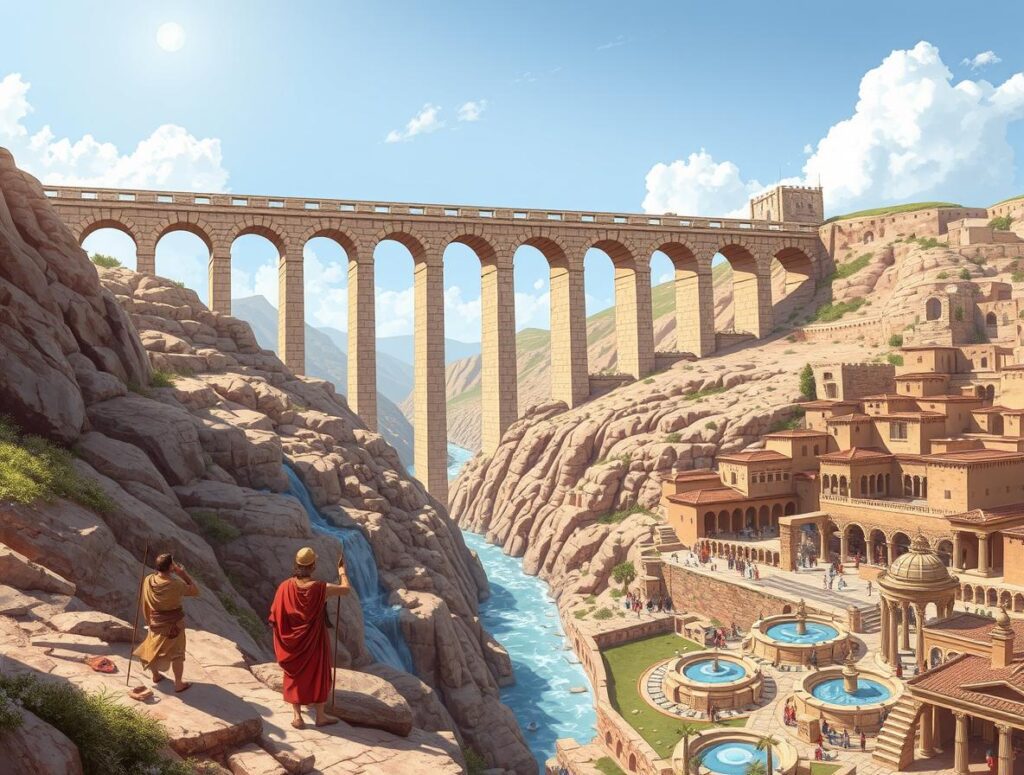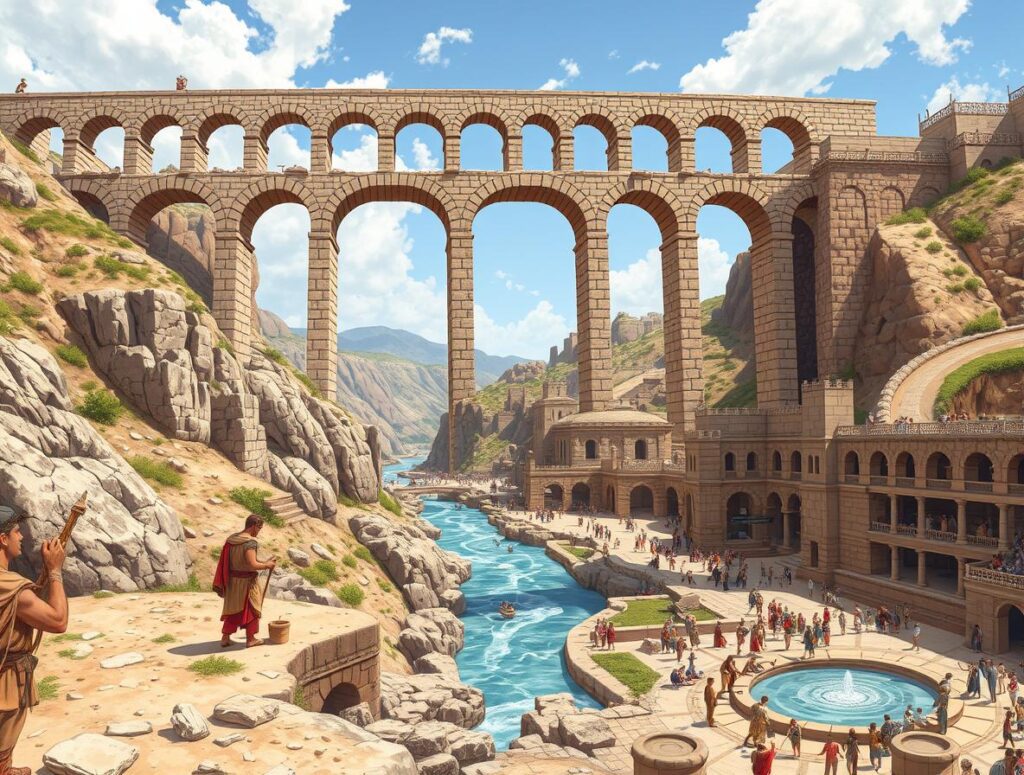The Hidden Engineering Marvel That Shaped an Empire
The water flows silently through channels carved into stone, defying gravity as it travels across valleys and through mountains. Without electricity, without modern pumps, without computer modeling, the liquid lifeline travels miles to reach its destination. When it arrives, it transforms a dusty settlement into a thriving metropolis where citizens enjoy amenities that wouldn’t be matched again for over a thousand years.
This isn’t science fiction. This was reality in ancient Rome, where engineers solved one of humanity’s most persistent challenges—reliable access to clean water—with a brilliance that continues to astonish modern experts. The Roman aqueduct system represents one of history’s most underappreciated technological revolutions, a feat so remarkable that many of its principles still underpin the water management systems serving our cities today.
What makes these achievements even more extraordinary is that they were accomplished with what we might consider rudimentary tools and materials. No computer simulations. No power equipment. No modern metallurgy. Just human ingenuity applied with remarkable precision.
The sophistication of Roman water management tells us something profound about innovation itself—that technological advancement isn’t always about complexity, but rather about the elegant application of fundamental principles. In many ways, the Romans weren’t just building infrastructure; they were establishing engineering principles that would stand the test of millennia.

Before the Aqueduct: Life in Water-Scarce Settlements
To appreciate the revolutionary nature of Roman water innovations, we must understand what life was like before them. Early settlements were invariably built near natural water sources—rivers, lakes, or springs. When these sources were insufficient or unreliable, human communities remained small and vulnerable to drought. The daily struggle for water shaped every aspect of life.
Water collection was labor-intensive and time-consuming. Imagine the hours spent walking to water sources, waiting in line, and carrying heavy containers back home. This burden typically fell to women and children, limiting their opportunities for education or other productive activities. The water itself was often contaminated, leading to disease outbreaks that could devastate communities.
Even in early Rome, before the construction of aqueducts, citizens relied primarily on the Tiber River, local springs, and shallow wells. The Tiber, like many rivers flowing through populated areas, served contradictory purposes—it was both a source of drinking water and a convenient place to dispose of waste. The health implications were severe, though not fully understood at the time.
The limitation of local water sources created a natural ceiling on urban growth. Cities could only expand as far as their water supply allowed, and water scarcity often triggered conflict between neighboring communities. Water wasn’t just a resource; it was power.
The Roman Water Revolution: Engineering Meets Public Policy
The genius of Roman water management wasn’t just in the engineering of aqueducts, but in the comprehensive approach that integrated technology, urban planning, and governance. The Romans didn’t simply build water channels; they created an entire water management ecosystem that transformed urban life.
The first Roman aqueduct, the Aqua Appia, was constructed in 312 BCE, marking the beginning of a water revolution that would eventually include 11 major aqueducts serving the city of Rome alone. These structures delivered an estimated 300 million gallons of water daily—a volume that would serve the needs of a modern city. This abundance of water enabled Rome to grow into a metropolis of unprecedented size for the ancient world.
The technical achievement of the aqueducts is difficult to overstate. Roman engineers had to solve complex problems of gradient, terrain, and water pressure using only the tools and materials available to them. The aqueducts maintained a careful slope—typically just 1 foot of descent for every 200 feet of distance—allowing water to flow consistently without stagnating or rushing too quickly and damaging the structures. This precision was achieved without modern surveying equipment, using instead water-filled troughs and calibrated rods to measure elevation changes over vast distances.
What truly set the Roman system apart was its integration with urban infrastructure. Water arriving in the city was directed to large settling tanks where impurities could sink to the bottom. From there, it flowed to distribution tanks and then through a network of lead, ceramic, or stone pipes to public fountains, baths, wealthy homes, and businesses. The system was carefully regulated, with priority given to public uses over private ones—a reflection of Roman civic values.

Beyond the Arch: The Hidden Sophistication of Roman Hydraulics
While the soaring arches of Roman aqueducts have become iconic symbols of ancient engineering, they represent only the most visible component of a sophisticated hydraulic system. The true complexity of Roman water management lies in elements that often remain hidden from the casual observer.
The Romans mastered the principles of water pressure and flow rate centuries before these concepts were formally defined by modern physics. They understood that water in enclosed pipes under pressure could be made to travel uphill for short distances—a principle they used to navigate difficult terrain. Their siphon systems could carry water across deep valleys without the need for impossibly tall arches, using the principle that water in a U-shaped pipe will rise to the same level on both sides.
Water quality was a primary concern, addressed through multiple ingenious solutions. Settling tanks removed sediment through gravity. Screens filtered out larger debris. Some aqueducts were even designed with intermediate pools where water slowed and was exposed to sunlight, which has natural purification properties. While the Romans didn’t understand germ theory, their empirical observations led them to develop systems that improved water purity.
The distribution network within cities showcased equally impressive engineering. Roman water engineers created junction boxes—distribution points where water could be directed to different areas as needed. These junction boxes often contained bronze calibrated nozzles of different sizes to control flow rates, essentially functioning as the ancient equivalent of modern flow meters. This allowed for the rational allocation of water during shortages and facilitated the collection of water taxes based on usage.
Perhaps most impressive was the Romans’ understanding of seasonal variations in water supply. Many aqueducts included overflow channels to handle excess water during rainy periods. Some systems incorporated multiple sources that could be adjusted according to seasonal availability. This kind of adaptive design shows a sophisticated understanding of long-term environmental patterns.
The Social Revolution: How Water Transformed Urban Life
The technical achievements of Roman water engineers transformed not just the physical landscape but the social fabric of urban life. The abundance of clean water enabled population densities that would have been impossible otherwise, allowing Rome to grow into a metropolis of perhaps a million people—a scale that wouldn’t be matched in Europe until the Industrial Revolution, some 1,500 years later.
Public health improved dramatically with access to clean water. While the Romans didn’t have a modern understanding of disease transmission, their empirical observations led them to associate clean water with better health. The separation of drinking water from waste disposal through their dual systems of aqueducts and sewers represented one of history’s first large-scale public health interventions.
The public bath became a central institution in Roman society, made possible only by the massive volumes of water delivered by aqueducts. These weren’t merely places for hygiene but served as community centers where citizens of different social classes mingled, discussed politics, and conducted business. The Roman baths, with their heated floors, steam rooms, and swimming pools, offered a level of comfort and luxury that wouldn’t be widely available again until the modern era.
Public fountains dotted Roman cities, ensuring that even the poorest citizens had access to clean water. This democratic approach to water distribution reflected Roman civic values and contributed to social stability. Water was seen not merely as a commodity but as a public good, essential to the functioning of society.
The consistent availability of water also transformed economic life. Industries that required significant water—tanning, dyeing, metalworking, food processing—could flourish within urban centers rather than being relegated to riversides. This concentration of economic activity created opportunities for innovation and specialization that drove economic growth.

Engineering for the Ages: Why Roman Water Systems Endured
Perhaps the most remarkable aspect of Roman water management was its durability. Many aqueducts continued to function for centuries after they were built, some remaining in service well into the modern era. The Aqua Virgo, constructed in 19 BCE, still supplies water to Rome’s Trevi Fountain today, after being restored over the centuries.
This longevity stems from several factors that modern engineers would recognize as principles of sustainable design. The Romans built for permanence, using durable materials like stone and concrete. Their famous concrete, made with volcanic ash, actually strengthens over time when exposed to water—a property that modern scientists are still working to fully understand and replicate.
Maintenance was built into the design of water systems. Inspection points and access channels allowed workers to clean sediment and repair damage without dismantling entire sections. The gradual slope of aqueducts prevented the buildup of destructive pressure and reduced erosion. These features made Roman water infrastructure remarkably resilient to both natural deterioration and human conflict.
The Romans also invested in documentation and knowledge transfer. Frontinus, appointed Water Commissioner of Rome in 97 CE, wrote a comprehensive treatise on the city’s water system, detailing not just the technical aspects but the administrative practices that ensured its proper operation. This emphasis on documenting both technical and organizational knowledge helped preserve expertise across generations.
Perhaps most importantly, the Romans created institutions specifically responsible for maintaining water infrastructure. The curator aquarum oversaw a staff of public slaves who were trained as specialists in aqueduct maintenance. This institutional commitment to upkeep was perhaps as important as the initial engineering in explaining the longevity of Roman water systems.
After Rome: The Loss and Rediscovery of Water Engineering
The fall of the Western Roman Empire led to a fragmentation of knowledge and institutional capacity that had profound implications for water management. Many aqueducts fell into disrepair or were deliberately destroyed during conflicts. The specialized knowledge required to maintain and repair these systems was often lost. Cities shrank, and with them the tax base needed to support large-scale infrastructure.
Throughout medieval Europe, water management regressed to more primitive methods. Many cities returned to relying on local wells and rivers, with all the public health consequences that entailed. The sophisticated urban water culture of the Romans gave way to a society where clean water was once again scarce and precious.
Yet the Roman legacy wasn’t entirely lost. In the Eastern Roman Empire (Byzantium), many water management techniques continued to be applied. The Islamic world preserved and extended Roman hydraulic knowledge, developing sophisticated water management systems in cities like Córdoba and Baghdad. The monastic traditions of Europe maintained some Roman water engineering practices, particularly in their agricultural applications.
The Renaissance saw a renewed interest in Roman engineering. Architects and engineers studied the remaining aqueducts, attempting to recover the principles that had made them so effective. Leonardo da Vinci’s notebooks contain numerous sketches of hydraulic systems inspired by Roman designs. This rediscovery of ancient knowledge played a crucial role in the development of modern hydraulic engineering.
The Industrial Revolution finally provided the technological capabilities to surpass Roman achievements in water management. Steam pumps eliminated the need for gravity-based systems, while new materials and construction techniques allowed for water infrastructure on an unprecedented scale. Yet even these modern systems owe a conceptual debt to Roman innovations.
Modern Echoes: Roman Principles in Contemporary Water Management
Today’s water engineers face challenges that would seem familiar to their Roman counterparts: delivering clean water to dense urban populations, managing seasonal variations in supply, and maintaining extensive infrastructure over long periods. While our technology has advanced dramatically, many of the fundamental principles established by the Romans remain relevant.
Gravity-fed water distribution systems, though now supplemented by pumps, still form the backbone of many municipal water supplies. The practice of separating drinking water from wastewater—a Roman innovation—remains a cornerstone of public health engineering. The concept of public access to water as a civic responsibility continues to influence water policy in many regions.
Even the Roman approach to water quality finds echoes in modern treatment systems. Sedimentation tanks, though now enhanced with chemical flocculants, operate on the same principle as Roman settling basins. Filtration, albeit with more advanced materials, follows the same conceptual approach. The multi-barrier approach to water treatment—addressing quality at multiple stages—has its origins in Roman practice.
Perhaps most significantly, the Roman emphasis on durable, maintainable infrastructure offers important lessons for contemporary planners. In an era when infrastructure is often built to minimum specifications with inadequate provision for maintenance, the Roman approach of building for centuries rather than decades provides a compelling alternative model.
As we face growing challenges of water scarcity and aging infrastructure, the Roman example reminds us that effective water management requires not just technical solutions but institutional commitment and public support. The Romans understood that water infrastructure was a generational investment, one that would serve their children and grandchildren.
The Lessons of Roman Water: What Ancient Innovation Teaches Us Today
The story of Roman water management offers profound insights that extend far beyond historical curiosity. It challenges our assumptions about technological progress and offers lessons that remain remarkably relevant in our own time.
First, it demonstrates that sophisticated engineering solutions can emerge from seemingly simple principles applied with extraordinary precision and attention to detail. The Romans didn’t have access to advanced materials or power equipment, but they achieved remarkable results through careful observation, empirical testing, and meticulous execution. This should remind us that technological advancement isn’t always about complexity; sometimes it’s about the elegant application of fundamental principles.
Second, the Roman approach illustrates the importance of systems thinking. They didn’t merely build aqueducts; they created comprehensive systems that addressed water from source to end-use and disposal. This holistic approach integrated technical, administrative, and social elements into a coherent whole. In our age of specialization, this reminder of the value of integrated thinking is particularly valuable.
Third, the durability of Roman water infrastructure highlights the importance of long-term planning. In an era when political and economic systems often prioritize short-term gains, the Roman willingness to invest in infrastructure that would serve generations offers a powerful counterexample. They built not just for themselves but for their descendants.
Finally, the Roman story reminds us that technological knowledge can be lost as well as gained. The decline of Roman water management systems during the early medieval period demonstrates that technological progress isn’t inevitable. It requires not just individual brilliance but sustained institutional support and cultural commitment.
As we confront the complex challenges of our own time—climate change, resource depletion, infrastructure renewal—these lessons from the distant past offer valuable perspective. The Romans faced the fundamental challenge of sustaining dense human settlements in environments with limited resources, and they developed solutions that sustained their civilization for centuries.
Their water management techniques weren’t just clever adaptations to their particular circumstances; they represent one of humanity’s great achievements in environmental engineering. By understanding and appreciating these ancient innovations, we gain not just historical knowledge but practical wisdom that can inform our own quest for sustainable development.
The flowing waters of Roman aqueducts, though largely silent now, still have much to teach us about the relationship between human ingenuity, natural resources, and societal well-being. In their elegant stone channels, we can see not just the reflection of a vanished empire but the enduring principles of engineering excellence and civic vision that transcend time.

